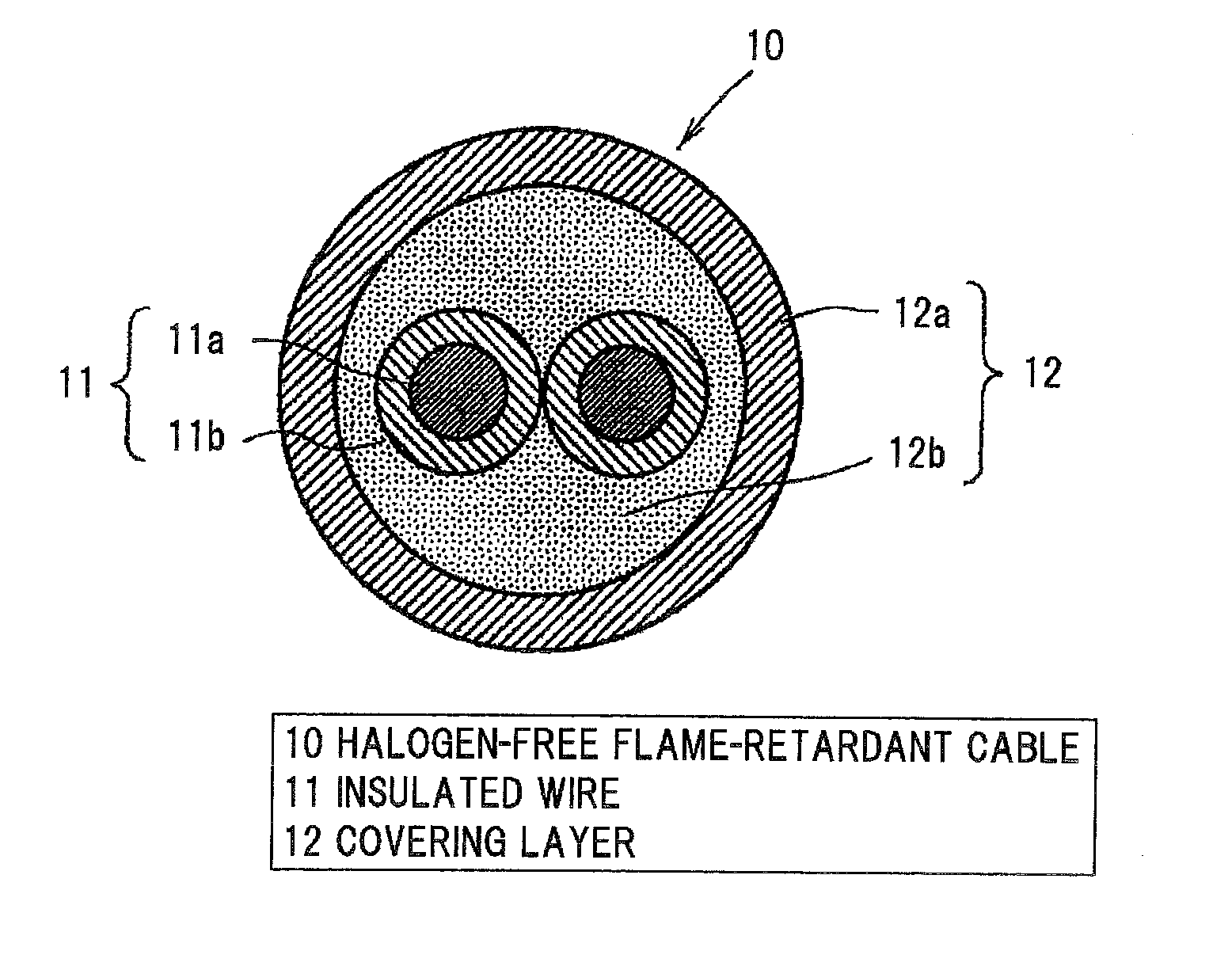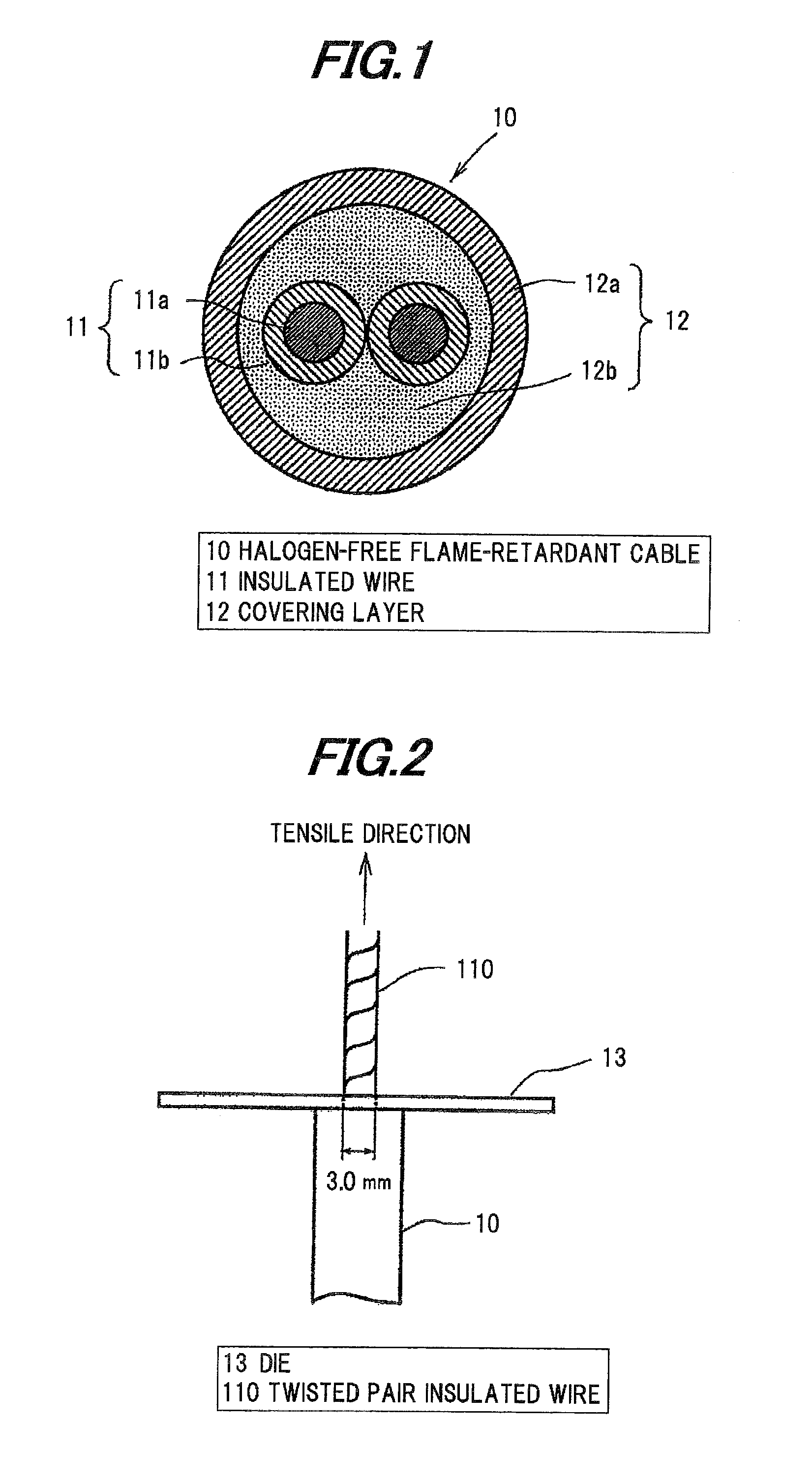Halogen-free flame-retardant cable
a flame-retardant cable, halogen-free technology, applied in the direction of cables, insulated conductors, conductors, etc., can solve the problems of bond strength decline, reduce bond strength, reduce flame retardance, the effect of preventing expansion
- Summary
- Abstract
- Description
- Claims
- Application Information
AI Technical Summary
Benefits of technology
Problems solved by technology
Method used
Image
Examples
examples
[0045]Table 1 shows Examples 1-11 and Comparative Examples 1 and 2.
TABLE 1(Unit of blending amount: parts by mass)ExamplesComparativeExamplesExamplesItems123456789101112Outer layerThermoplastic polyurethane100100100100100100100100100100100100100material(TPU)1)Melamine cyanurate (MC)2)30303050100100100303040110 25 25Aromatic condensed phosphate01103003030003530 0 0ester3)Inner layerEthylene-vinyl acetate100materialcopolymer4)(VA content = 25%)Ethylene-vinyl acetate100copolymer5)(VA content = 33%)Ethylene-vinyl acetate100100100100100100100100100100100copolymer6)(VA content = 46%)Irradiance level (kGy)20020020020020020020010050200200200200EvaluationTensile strength (MPa)15.314.914.913.510.910.511.014.915.113.29.7 15.9 16.1Elongation (%)390380380350230220230360400340200380380Heat resistancePassPassPassPassPassPassPassPassMoltenPassPassPassPassFlame retardance (second)10542322131322 30≦ 30≦Gel fraction (%)7878777573737562437577 78 75Abrasion resistance (m)23.122.621.018.211.010.811.2...
examples 1-11
[0058]Using ET890 (from BASF Japan Ltd.) as the thermoplastic polyurethane (TPU), MC-5S (from Sakai Chemical Industry Co., Ltd.) as the melamine cyanurate (MC) and the aromatic condensed phosphate ester PX-200 (from Daihachi Chemical Industry Co., Ltd.) as the phosphorus compound for the outer layer material and using the EV170 (from DuPont-Mitsui Polychemicals Co., Ltd) as EVA (VA=33%) or EV45LX (from DuPont-Mitsui Polychemicals Co., Ltd) as EVA (VA=46%) for the inner layer material, the inner and outer layers were formed at the composition shown in Table 1, and were cross-linked at an electron beam irradiance level of 200-50 kGy.
PUM
| Property | Measurement | Unit |
|---|---|---|
| outer diameter | aaaaa | aaaaa |
| outer diameter | aaaaa | aaaaa |
| outer diameter | aaaaa | aaaaa |
Abstract
Description
Claims
Application Information
 Login to View More
Login to View More - R&D
- Intellectual Property
- Life Sciences
- Materials
- Tech Scout
- Unparalleled Data Quality
- Higher Quality Content
- 60% Fewer Hallucinations
Browse by: Latest US Patents, China's latest patents, Technical Efficacy Thesaurus, Application Domain, Technology Topic, Popular Technical Reports.
© 2025 PatSnap. All rights reserved.Legal|Privacy policy|Modern Slavery Act Transparency Statement|Sitemap|About US| Contact US: help@patsnap.com


